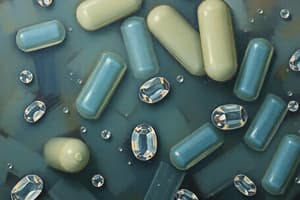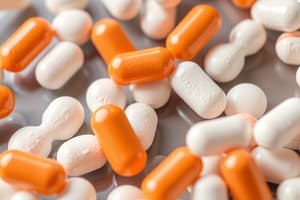Podcast
Questions and Answers
Which characteristic of beta-lactam antibiotics leads to bacterial cell lysis and death?
Which characteristic of beta-lactam antibiotics leads to bacterial cell lysis and death?
- Enhanced synthesis of peptidoglycan strands.
- Inhibition of bacterial DNA replication.
- Interference with bacterial protein synthesis.
- Compromised cell wall strength due to obstructed peptidoglycan cross-linking. (correct)
Which structural component is essential for the antibacterial activity of penicillins?
Which structural component is essential for the antibacterial activity of penicillins?
- Beta-lactam ring. (correct)
- Thiazolidine ring.
- Carboxyl group.
- Acyl side chain.
A patient is prescribed Penicillin G Benzathine. Why is this form of penicillin preferred over regular Penicillin G in some situations?
A patient is prescribed Penicillin G Benzathine. Why is this form of penicillin preferred over regular Penicillin G in some situations?
- It is more acid-stable.
- It is less affected by food intake.
- It has better oral bioavailability.
- It provides a prolonged duration of effect due to its insolubility in water. (correct)
Which of the following best describes the mechanism by which bacteria can develop resistance to penicillins?
Which of the following best describes the mechanism by which bacteria can develop resistance to penicillins?
Which property of amoxicillin contributes to its improved Gram-negative coverage compared to penicillin G?
Which property of amoxicillin contributes to its improved Gram-negative coverage compared to penicillin G?
Why is cilastatin administered in combination with imipenem?
Why is cilastatin administered in combination with imipenem?
A patient with a known penicillin allergy requires treatment for a bacterial infection. Which class of antibiotics might be considered, keeping in mind the potential for cross-sensitivity?
A patient with a known penicillin allergy requires treatment for a bacterial infection. Which class of antibiotics might be considered, keeping in mind the potential for cross-sensitivity?
What is the main advantage of using 4th generation cephalosporins like cefepime and cefpirome compared to earlier generations?
What is the main advantage of using 4th generation cephalosporins like cefepime and cefpirome compared to earlier generations?
Which of the following best explains the role of clavulanic acid in combination with amoxicillin?
Which of the following best explains the role of clavulanic acid in combination with amoxicillin?
Which factor contributes to the increased resistance of later-generation cephalosporins against beta-lactamases?
Which factor contributes to the increased resistance of later-generation cephalosporins against beta-lactamases?
Flashcards
Penicillin Mechanism of Action
Penicillin Mechanism of Action
Inhibition of bacterial cell wall synthesis by binding to and inhibiting penicillin-binding proteins (PBPs)
Bacterial Resistance to Penicillin
Bacterial Resistance to Penicillin
Some bacteria are naturally resistant, biochemical mechanisms include enzyme production (β-lactamases), permeability changes, porin structure alteration and changed PBP affinity.
Beta-Lactam Ring
Beta-Lactam Ring
Crucial for antibacterial activity by binding to and inhibiting PBPs, preventing bacterial cell wall synthesis.
Acyl Side Chain (R-group)
Acyl Side Chain (R-group)
Signup and view all the flashcards
Penicillin G
Penicillin G
Signup and view all the flashcards
Methicillin
Methicillin
Signup and view all the flashcards
Ampicillin
Ampicillin
Signup and view all the flashcards
Cephalosporins MOA
Cephalosporins MOA
Signup and view all the flashcards
Cephalosporin Generations
Cephalosporin Generations
Signup and view all the flashcards
Beta-Lactamase Inhibitors
Beta-Lactamase Inhibitors
Signup and view all the flashcards
Study Notes
- The text provides a detailed overview of antibacterial antibiotics, specifically focusing on penicillins and cephalosporins, including their history, mechanisms of action, resistance, and structure-activity relationships
History of Antibiotics
- Alexander Fleming discovered penicillin serendipitously in 1929, which was later initiated into therapy by Howard Florey and Ernst Chain
- Louis Pasteur and Jules Joubert observed in 1877 that certain bacteria could inhibit the growth of others
- Selman Waksman discovered Streptomycin, the first effective agent against TB, cholera, and typhoid fever in 1943 and also isolated Neomycin
Antibiotics
- Antibiotics are products of metabolism or synthetic analogs that antagonize the growth of microorganisms, effective in low concentrations
Other Terminologies
- Empiric Therapy involves administering treatment before a definitive diagnosis is made
- Definitive Therapy involves treatment after diagnosis
- Selective Toxicity refers to drugs selectively targeting bacterial cells while disregarding human cells
- Chemotherapeutic Spectra are classified as narrow, extended, or broad-spectrum, depending on their range of activity against different microorganisms
Bacterial Resistance
- Some bacteria, especially Gram-negative bacteria, exhibit natural resistance to antibiotics
- Biochemical mechanisms of penicillin resistance include bacterial elaboration of enzymes (β-lactamases), decreased permeability of penicillins, changes in the number and nature of porins, and altered affinity of penicillin-binding proteins (PBPs)
- Gram-negative bacteria include Bacilli like Escherichia coli, Helicobacter pylori, Legionella pneumophila, and Cocci like Neisseria gonorrheae and Neisseria meningitidis
Beta-Lactam Antibiotics: Penicillins
- Penicillins inhibit bacterial cell wall synthesis by binding to and inhibiting penicillin-binding proteins (PBPs) and obstruct the cross-linking of peptidoglycan strands, compromising the cell wall, leading to bacterial cell lysis and death
General Structure of Penicillins and SAR
- Beta-Lactam Ring is crucial for antibacterial activity and modification leads to loss of activity
- Thiazolidine Ring is important for stability and binding to PBPs, contributing to the correct positioning of the β-lactam ring
- Acyl Side Chain/R-Group determines the spectrum of activity, β-lactamase resistance, and pharmacokinetics, located at position 6 on the β-lactam ring
- Carboxyl (-COOH) Group is hydrophilic and enhances water solubility, affecting drug absorption, distribution, and excretion
Natural Penicillins
- Penicillin G (Benzylpenicillin) is the DOC for Syphilis but is given IV/IM due to acid-labile nature
- Penicillin V (Phenoxymethylpenicillin) is acid-stable and given PO, with uniform concentration in the blood
Penicillinase Resistant/Anti-Staphylococcal Penicillins
- Methicillin is the prototype PDR penicillin, not inactivated by penicillinase, but has adverse effects like severe interstitial nephritis and nephrotoxicity
- Nafcillin has substituents in positions ortho to the point of attachment of the aromatic ring and can be used in patients with renal failure
- Oxacillin is restricted to the treatment of infections caused by staphylococci resistant to Pen G and is highly resistant to inactivation by penicillinase
- Cloxacillin has a Cl- atom ortho to the position of attachment of the phenyl ring, enhancing its oral absorption
- Dicloxacillin has chlorine atoms on both carbons ortho to the position of attachment of the phenyl ring, to enhance its stability and produce high plasma concentrations
Aminopenicillins
- Ampicillin has a broader antibacterial spectrum than Pen G and is used to treat infections caused by gram (-) bacilli
- Amoxicillin has an antibacterial spectrum similar to ampicillin, resistant to acid, and absorption is not impaired by food
Carboxypenicillins
- Carbenicillin is the prototype in carboxypenicillins and is effective in the treatment of systemic & UTI caused by P. aeruginosa, Proteus spp and Providencia spp
- Ticarcillin is an isostere of carbenicillin and has an antibacterial spectrum similar to carbenicillin
Ureidopenicillins
- Mezlocillin has a similar antibacterial spectrum to carbenicillin & ticarcillin and more active against most Klebsiella spp, P. aeruginosa and anaerobes
- Piperacillin is the most potent ureidopenicillin
Carbapenems
- Imipenem is the first-ever carbapenem, has potent antibacterial activity and is inactivated by dehydropeptidase-1 (DHP)
- Cilastin is a DHP inhibitor, used with Imipenem
- Thienamycin is derived from Streptomyces cattleya
Monobactams
- Aztreonam is active against aerobic gram (-) bacilli and used to treat urinary, lower RTI, intra-abdominal & gynecological infections, & septicemias
Beta-Lactamase Inhibitors
- Class I Inhibitors possess an atom leaving group at position 1, prolong inactivation by enzymes and prevent degradation of β- lactams
- Clavulanic Acid has a broad spectrum activity when combined, covering Gram-positive, Gram-negative and anaerobic bacteria
- Sulbactam is a synthetic penicillin derivative, and is used in tx of skin, tissue, intra-abdominal, & gynecological infections
- Tazobactam is more potent than sulbactam
Cephalosporins
- Cephalosporins inhibit bacterial cell wall synthesis by binding to penicillin-binding proteins (PBPs) involved in peptidoglycan synthesis
- They are categorized into generations, with later generations generally having increased resistance to β-lactamases and broader Gram-negative activity
- ADRs can include cross-sensitivity with penicillins, hypersensitivity reactions, and severe reactions
Cephalosporin SAR
- Beta-Lactam Ring binds to Penicillin-Binding Proteins (PBPs), inhibiting peptidoglycan synthesis
- Dihydrothiazine Ring increases β-lactamase resistance & greater stability in acidic conditions
- Acyl-Side Chain/R-Group affects affinity to PBPs
Cephalosporin Generations
- Cefazolin, Cephalexin, and Cefadroxil are 1st Generation Cephalosporins with the best Gram-positive coverage
- Cefotetan, Cefoxitin, and Cefuroxime are 2nd Generation with better Gram-negative coverage
- Cefotaxime, Ceftazidime, and Ceftriaxone are 3rd Generation Cephalosporins with strong Gram-negative coverage
- Cefepime is a 4th Generation Cephalosporin, covers pseudomonas and is highly beta-lactamase resistant
- Ceftaroline fosamil and Ceftobiprole are 5th Generation Cephalosporins and have Anti-MRSA activity
Studying That Suits You
Use AI to generate personalized quizzes and flashcards to suit your learning preferences.




